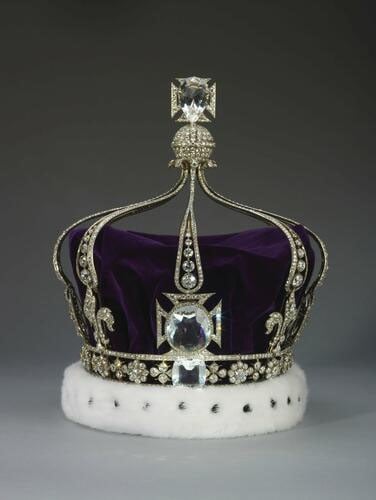The Controversial Diamonds Queen Camilla May Wear to King Charles’ Coronation
3 Minute Read
The United Kingdom's newest Queen Consort will wear Queen Mary's crown for her and King Charles III's coronation at Westminster Abbey this Saturday, May 6, 2023.
But, Buckingham Palace has decided to make a major alteration to the crown ahead of the big day, removing the controversial and colonial-era Koh-i-Noor diamond. However, now, the diamonds that are replacing the Koh-i-Noor are also causing their own controversy.
The Koh-i-Noor Diamond Controversy
The Koh-i-Noor diamond is one of the largest cut diamonds in the world, weighing 105.6 carats. Famously, it was placed at the center of Queen Mary's crown for her own coronation back in 1911, only to be moved to the Queen Mother's crown for her and King George VI's coronation. Since the Queen Mary's crown has featured a replica. And now for King Charles III's coronation, it will be refitted to feature another set of gems with a controversial colonial past, the Cullinan III, IV and V diamonds.
But, the Koh-i-Noor diamond isn't controversial for its placement on royal crowns. Thought to be mined in India, this world-famous gem is claimed by several countries across the subcontinent and has been demanded to be returned by multiple states. Part of the British crown jewels since 1849, the history of the diamond is unclear, but stories date it back as far as Mesopotamian texts from 3200 BCE, and we know that the diamond traded hands through several dynasties, from the Mughals to the Persians, Afghans and finally Sikh Maharaja Ranjit Singh.
Then in an incredibly controversial move, Sikh Maharaja Ranjit Singh's son and successor, Maharaja Duleep Singh, gave the diamond to the queen of England in 1849 while signing the Treaty of Lahore. Just 11 years old, he's believed to have been coerced into the decision by a British statesman.
Shipped off to the United Kingdom, the Koh-i-Noor was put on display at the Great Exhibition of 1851 with much public disappointment because the cut wasn't very bright. There was already a lot of controversy about the diamond, with many calling out the East India Company for its role in imperialism in India. In an effort to mitigate the scandal, the Koh-i-Noor was recut to half its original size, making it much shinier but taking the weight down to 105 carats.
The Cullinan Diamonds Controversy
Specially fitted for the ceremony that will crown her queen, the Queen Mary Crown has been refitted to feature the equally famous Cullinan III, IV and V diamonds. Worn by Queen Elizabeth II as broaches, the diamonds now fitted on the crown are a nod to the late Queen's 70-year reign. However, these gems, which originate from South Africa, are also being called out for their colonial past.
The Cullinan, which is the world's largest diamond, was discovered in South Africa in 1905 in a Pretoria mine, originally weighing an incredible 3,106 metric carats in its uncut state. Cut into nine large stones and 100 smaller stones, including the 530-carat Star of Africa, which is set in the Sovereign's Sceptre With Cross, today all of the gems are part of the British Crown Jewels. Gifted to the royal family in 1907 by the South African Republic, the diamond was thought to serve as a symbol of peace and respect with the monarchy after a war had erupted between the two states. However, the controversy around the Cullinan diamonds stems from the fact that the gem was originally purchased by South Africa's Transvaal government, which was under British rule at the time, anyways. Today, there are calls to return the Cullinan diamonds back to South Africa.
Cate Misczuk
Cate Misczuk is a jewelry and watch writer who covers everything from the latest jewelry trends and the heritage of watchmaking to 24k gold, gems, sustainability, unisex timepieces and more. Get in touch at catemisczuk.com.
Related Articles
World’s Biggest & Rarest Colored Gems Are on Display in L.A.
Exclusive Industry Interview: Clean Origin CEO Alexander Weindling Predicts Explosive Growth For Lab-Grown Diamonds
Sotheby’s Sells 555.55-ct Enigma Diamond for $4.3m
What Gems Kate Princess of Wales Will Wear to King Charles III’s Coronation
Latest Articles
Quartz Toxicity: Understanding the Risks for Jewelers and Wearers
Synthetic Amethyst: What is it and How is it Made?
Hambergite Value, Price, and Jewelry Information
Pearl Simulants: How to Spot Faux Pearls
Never Stop Learning
When you join the IGS community, you get trusted diamond & gemstone information when you need it.
Get Gemology Insights
Get started with the International Gem Society’s free guide to gemstone identification. Join our weekly newsletter & get a free copy of the Gem ID Checklist!
